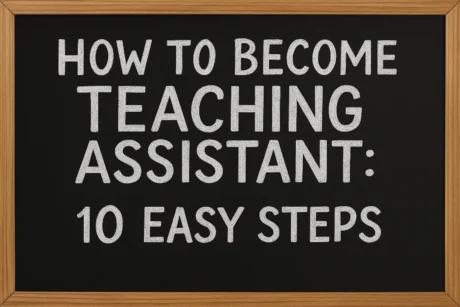Want to know how to become teaching assistant? In fact, around 282,900 full-time equivalent (FTE) teaching assistants worked in schools across England in 2024—a nearly 2% rise from the year before—showing just how much demand there is for support staff.

Getting started is easier than you think. First, make sure your English and maths are good enough. Then sort an enhanced DBS check, read the safeguarding Part 1 guide, and get some classroom experience—even just a few sessions help. Once you’ve done that, you can apply straight to schools or try a Level 3 Teaching Assistant apprenticeship to get paid while you learn and kick off your career in education.
How to Become Teaching Assistant

Step 1: Check the basics (English, maths, and right to work)
First things first—make sure your English and maths are okay.. Schools just need to know you can read, write, and handle numbers. A GCSE grade 4/C or Functional Skills Level 2 usually works. Also, check your right to work in the UK and keep your ID or passport handy. Being organised makes applying much easier and shows schools you’re ready.
Once your basics are in place, the next step is to understand how to keep children safe in the classroom…
Step 2: Get safeguarding-savvy
Before you go into a classroom, read Keeping Children Safe in Education – Part 1. It basically tells you how to keep kids safe and what to do if you notice anything worrying. Every school expects you to know this—it’s really important. It also helps you feel confident when supporting pupils and shows teachers you take safety seriously. Even a quick read can make a big difference.
Pro tip: Boost your knowledge and stand out by taking the Level 2 Safeguarding Children Training Course at Unified Course.
Step 3: Sort your Enhanced DBS
If you’re going to work with kids, you’ll need an Enhanced DBS check. Some schools will sort it for you, but often you’ll need to have it ready before you start. It’s just a quick safety check to show you’re safe to be around children.
With your DBS sorted, the next big step is deciding how you want to get your first teaching assistant role…
Step 4: Choose your route (apply direct, apprenticeship, or volunteer-to-paid)
There are a few ways to start as a TA. You can apply straight to schools through your local council, academy trust, or the DfE Teaching Vacancies site. You could also do a Level 3 Teaching Assistant apprenticeship—you get paid while learning on the job. Or just volunteer first for a bit; it’s a great way to get experience and often leads to a paid role later.
Step 5: Get a little classroom experience
Try to spend some time in a classroom, even if it’s just a few sessions. You could help with reading groups, give 1:1 support, or assist a teacher for a morning. This hands-on experience helps you see what the job is really like and gives you practical examples to mention in your application. Plus, it shows schools that you’re serious and ready to step in and help. Even a short stint can make a big difference when applying.
After a taste of classroom life, it’s time to make your CV shine…
Step 6: Write a tiny, focused CV and note
Keep your CV short and easy—just one page. Highlight any time you’ve worked with kids, as well as your safeguarding know-how, and how you help with calm behaviour. Mention your confidence in English and maths, and if you’ve helped children with SEND or EAL. Finally, make it friendly and warm so schools can see you’d be great to have around.
With your CV ready, the next step is to start applying for real roles…
Step 7: Apply for live roles
Don’t wait around—start applying as soon as you can. First, check Teaching Vacancies for jobs like “Teaching Assistant,” “SEN TA,” or “1:1 support” in your area. You can also set up alerts so new roles pop straight into your inbox. This way, you’ll see opportunities as soon as they come up, and you won’t miss a chance to land a role that’s right for you.
Once you land an interview, it’s time to show schools what you can do…
Step 8: Interview like a TA (not a teacher)
When you go for an interview, remember they want to see how you work as a TA, not as a teacher. First, be ready for questions like “How do you keep pupils safe?” or “Can you give an example of helping a child learn?” You might also get asked “What would you do if you were worried about a pupil?” and “How do you support behaviour in a kind and consistent way?” Make sure you show that you understand safeguarding and take it seriously. Also, try to give real examples from any experience you’ve had—it helps schools see how you’d handle things in the classroom.
Step 9: Know the job you’ll do
A great TA helps the teacher’s plan come to life. You give quick feedback, guide children, and help them learn to do things on their own—not rely on you for everything. Also, it’s important to notice when someone needs a bit more help and step in without taking over. Schools love to see this from day one because it makes learning smoother, boosts kids’ confidence, and shows you know how to support them well.
Step 10: Plan your next step (progression is common)
Once you’ve got some experience as a TA, you can start taking on bigger responsibilities—these roles are often called HLTA. You could also choose to specialise in areas like SEND, the curriculum, or wellbeing, which makes your work even more valuable. Plus, there’s a Specialist Teaching Assistant apprenticeship if you want to get formal training while you work. By planning your next step, you keep learning, grow in confidence, and open up more opportunities for your career.
Where to find real jobs
The best places to look are the DfE Teaching Vacancies site and your local council or trust websites. Also, take a good look at the real job adverts—they tell you all the key details like hours, weeks paid, and whether the role involves SEND support. This way, you can quickly see if a job is a good fit. By paying attention to these details, you save time and make sure you’re applying for roles that really suit you.
Working With Teachers (Building a Good Partnership)
TAs do their best work when they talk openly with teachers, ask questions, and share what they notice about pupils. By keeping the conversation going, you help lessons run more smoothly and make sure every child gets the support they need. Also, when you give useful observations to teachers , it shows that you’re engaged and really paying attention to how the kids are doing.
Supporting Children With SEND

Many TA roles involve helping children with special educational needs (SEND). Because of this, patience and giving clear instructions are really important. Also, being willing to learn new strategies can make a big difference in how well you support them. When you take the time to understand each child’s needs, it helps them feel confident and makes your work much more effective.
Training You Can Do for Free (That Makes You Stand Out)
There are lots of free ways to boost your skills and stand out as a TA. For example, you could do online safeguarding refreshers, try short SEND awareness courses, or use free resources from the DfE and charities. Also, taking part in Continuous Professional Development (CPD) shows schools you’re serious about growing in your role. These quick trainings give you practical knowledge without feeling overwhelmed and help you build your career step by step.
Pay and Contracts (Simple View)
Most TA pay is term-time only, but it’s usually spread out evenly over 12 months. Also, contracts can be full-time or part-time, depending on the school and role. This way, it’s easier to plan your money while still enjoying school holidays.
From TA to Teacher (If You Ever Fancy It)
Many teachers actually started as TAs, so working as a teaching assistant can be a brilliant first step if you ever want to train as a teacher. It gives you real classroom experience and helps you see how lessons run. Also, it lets you understand how teachers plan and support learning, while building your confidence with pupils and school routines. This makes moving into teacher training much easier.
The Reality of Being a Teaching Assistant

Being a teaching assistant is a really rewarding job, but it’s not always easy. You need good English and maths, a DBS check, and some classroom experience. Pay can be low, contracts are often temporary or term-time only, and moving up to higher roles takes extra training.
Research shows this isn’t just one person’s experience. Lots of TAs feel underpaid, sometimes treated like “dogsbodies,” and juggle tons of tasks—helping with lessons, supervising clubs, preparing resources, and supporting kids with tricky behaviour or special needs like autism or ADHD. On top of that, competition for jobs can be tough, and many feel undervalued even with years of experience.
Even with all that, it’s a great job if you enjoy helping kids learn and grow. Still, better pay, proper training, and recognition would make the role feel more fair for all the hard work TAs do.
Source: BBC News.
Conclusion
Learning how to become teaching assistant is a really rewarding way to make a difference in kids’ lives. But it’s not always easy—you’ll juggle lots of tasks, support children with different needs, and sometimes feel underappreciated. Even so, with the right skills and experience, you can build a great career, gain confidence, and even take steps toward becoming a teacher later on.
If you’re ready to get started, the Teaching Assistant Course at Unified Course is a practical way to learn the essentials, gain confidence, and stand out to schools.
Start your journey today and take your first step in becoming a teaching assistant!





